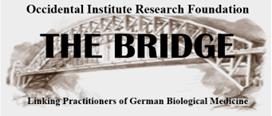Better and earlier detecting of heart failure
(heart insufficiency) and treating it naturally
Heart failure is often diagnosed too late
Diagnosis of heart failure is still correlated with an unfavorable outcome in spite of our advanced state of knowledge in medicine and it could be compared to a serious tumor disease. This has not changed significantly within the past years in spite of the diagnostic and therapeutic possibilities. May promising developments such as inhibitors of phosphodiesterase or directly adrenergic positive stimulating substances have finally disappointed and many things indicate that it will not be any different with the strongly vasdilatory drugs. They have been administered to decisively reduce heart labor but by secondary provocation of the autonomous nerve system they do more harm than anything else. The logic consequence of this difficult therapeutic situation must be to improve special diagnostics in order to grasp the prognostically more favorable preliminary stages. As early as possible, so that life quality may be maintained.
Problems detecting heart failure early on
Unfortunately we routinely see that the patient herself/himself senses the danger and pays a visit to the doctor. The patient has not been felling well for a long time and often describes very precisely how she/he sees her/his fitness diminishing. If there is a great discrepancy between the patient’s perception of well being and the result of the examination, we must resume our search. Results of examination are often not as good as the perception of the patient and it is advisable to follow the patient’s own observations.
Why is heart failure overlooked so often?
There are several reasons why heart failure is overlooked so often. For one thing physicians have not yet internalized the dichotomy of the heart insufficiency. The differentiation of systolic heart insufficiency that is accompanied by a poorly contacting heart during systole, and the diastolic heart insufficiency that is accompanied by a very well contracting heart that does not adequately expand during diastole and therefore does not take up enough blood. In both forms of heart insufficiency the efficiency of the cardiovascular system, the heart minute volume is decreased significantly. The genuine efficiency of the cardiovascular system can often only be obtained secondarily. Special importance in diagnostics is given to ultrasonic testing. With this the so-called ‘ejection fraction’ is determined, an important parameter. The ejection fraction is defined as the percentage that is released with every heartbeat prior to the filling of the heart. The ejection fraction is only sensible for characterization of the systolic heart insufficiency. The diastolic hear insufficiency is characterized by a high ejection fraction even though the heart minute volume is small. Because the ejection fraction is used improperly as a decisive parameter the diastolic heart insufficiency is not given the significance it should receive, although it is a more common form of heart failure and often represents the preliminary stage of subsequent systolic heart insufficiency.
Heart insufficiency is clinically diagnosed too late because the organism is trying to cover up the effect of heart insufficiency as long as possible. Water is absorbed into the circulating blood so that the heart is filled with a greater volume and ejection is improved (Frank Starling rule). When the efficiency of the heart declines and water is taken into either the small or large circulation or both by the described regulatory systems, the power of the heart will first remain strengthened so that the patient will still be able to maintain his daily routine. Sometimes patients are very surprised when complications of a long beforehand existing blood congestion suddenly appear, i.e. congestions of veins and inflammation of the lower leg, symptoms similar to asthma or hear rhythm problems that are caused by the excessive stretching of the overstressed atriums, strong heartbeat or even auricular fibrillation. The pathophysiology and the regulatory mechanisms of compensation during heart insufficiency have been studied and available for a long time and are generally well-known. Nonetheless diagnostics have not been thoroughly made use of which would be especially worthwhile, and we are more than astounded by the meaning and significance of the double hematocrit and it’s clinical relevance.
Diagnostics and therapy of the early heart insufficiency
Double hematocrit
The right side of the heart is mostly first affected because it is naturally the weaker one and it can not achieve efficient pressure. In addition the small right heart is preliminary to the left heart and must work against the whole lung blood vascular system in case of a cardiac insufficiency, when the left heart can not take over the blood-lung volume. It must therefore account for the insufficiency of the left heart. Nonetheless patients with an organic left heart defect, i.e. aorta stenosis, often develop pretibial edema on the lower legs as first visible signs of heart insufficiency in relation to secondary right heart insufficiency.
The early dilution of the venous versus the arterial circulation allows an astounding and simple diagnosis of the early heart insufficiency. If hematocrit (HTK) is measured in both the venous and the arterial (capillary) circulation (double hematocrit DHK), the venous is normally 0.5% points higher than the capillary value. According to these statements a dominant dilution can be observed during early heart insufficiency in the venous circulation. The venous hematocrit is lower than the arterial hematocrit in the event of heart insufficiency. If even a small phlebotomy of 80-100 ml is carried out (diagnostic bloodletting) and the phenomena has vanished after a control after 24 hours, then the small phlebotomy has not only been a means of diagnosis but also has been effective therapeutically (therapeutic bloodletting). By using self-developed computer programs a concentration after phlebotomy may be determined in ml and severity of heart insufficiency may be assessed. Thus a new tool is available for diagnosis of heart insufficiency. In its simplicity it may hardly be surpassed in terms of significance and cost.
Volume Electrocardiogram (ECG)
Double hematocrit may help determine different grades of heart insufficiency only, but not distinguish between systolic or diastolic heart insufficiency. Therefore we have developed our own instrument that we could not do without, the volume electrocardiogram (ECG). From our viewpoint the utilization is a considerable improvement of the information achieved by the conventional ECG and may be derived as usual.
The digitalized data is illustrated in three main levels according to the input of our won computer program. The vector cardiographic figures for the normal lying position, after different phases of strain, and with raised legs are mathematically projected over each other.
A pronounced diastolic heart insufficiency is characterized by considerable irregularities of the ECG-curves in the phase with stretched out legs in comparison to those with raised legs. The extent of deviation is parallel to the intensity of dysfunction of expansion and parallel to the occurrence of hyper-volemia which intensifies the dysfunction of expansion. By contrast the deviation decreases after therapeutic decrease of pressure of the blood volume on the inner layers either by a modified blood volume therapy or mitigation of hyper-contraction of in case of an overactive sympathetic nervous system.
By contrast a purely systolic heart insufficiency with a big inactive ventricle will not show any differences in the curves, just as a healthy ventricle with expandable myocardium may hold the increased blood volume without any problems even after raising the legs. The volume ECG is a suitable instrument for the control of the course of hyper-volemia of heart insufficiency and the resulting diastolic disturbance of expansion over any other method. The therapeutic approach may partly be observed after days or even hours and may be confirmed or determined as ineffective or harmful.
The symptoms of the hidden heart insufficiency:
The internal heart pressure syndrome
The symptoms of the hidden heart insufficiency are usually not noticeable during the day while standing or sitting and were not correlated to heart insufficiency by etiology. They emerge as a result of a hydraulic phenomenon when the increased blood volume of the compensated heart insufficiency presses on the delicate inner layers of the cardiac walls and causes a relatively decreased blood circulation. The decrease of blood circulation will activate part of the sympathetic nervous system which will regulate the emergency. The sympathetic nervous system is in this case all but helpful. It has a reinforcing impact on the heart, which now contacts and becomes even smaller and may hold even less blood.
Furthermore the sympathetic nervous system constricts the peripheral vessels and decreases their capacity and more blood flows into the interior of the heart and intensifies the internal pressure of the heart. A vicious circle evolves because the increased internal pressure causes the impairment of the blood circulation thus further activating the sympathetic nervous system until i.e. the patient is awakened during his sleep or is heavily perspiring with a pounding heart at 3 AM and can not go back to sleep. This symptomatic is worsened by a large food/drink intake before going to sleep and improves with drinking abstinence after 7 PM. Getting up and walking around at night is also helpful because the pressure is reduced when the blood volume flows to the legs. In advanced cases of heart insufficiency the activation through the sympathetic nervous system takes place directly after lying down and is the cause of a direct and continuous loss of fatigue.
We have developed a questionnaire on hidden heart insufficiency that is suitable for the self-questioning of patients.
If the symptoms are not eliminated in the long run a serious lift threatening coronary heart disease could not be ruled out.
To see Dr. Hain’s Quesstionnaire and Results please follow this link:
https://oirf.com/2005/12/08/questionnaire-and-results/

An exclusive translated article for Affiliates
From THE BRIDGE Newsletter of OIRF
Published December 8, 2005
Translated by Juliette Fong, Basel, January 2004
© Copyright 2004, Dr. Peter Hain, Bad Nauheim, Germany



